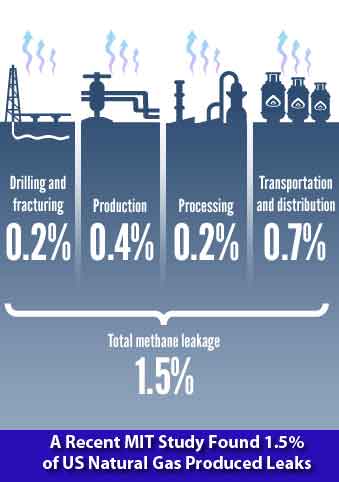Several years ago, it looked like natural gas powered heavy duty trucks were gaining momentum, offering lower cost operations while reducing a carrier or shipper’s carbon foot print at the same time.
But that market momentum has clearly slowed, with heavy duty natural gas truck sales falling well behind previous estimates. (See Growth of Natural Gas Trucks Not Reaching Levels Many Expected.)
The continued high cost of nat gas trucks combined with falling oil and thus diesel prices have altered the cost and ROI equation for making the move to natural gas. And reports about the total greenhouse gas emissions from using natural gas fuel are causing some to question the environmental benefits as well.
On the road, while cleaner natural gas releases less CO2 than diesel to the atmosphere when it is combusted - as much as 30% less, though estimates vary - methane leaks from the production and transportation of natural gas has the potential to remove some or all of the climate benefits companies are looking for from making the move to natural gas.
In August, a study published in the journal Environmental Science & Technology found that natural gas gathering facilities, which collect from multiple wells, lose about 100 billion cubic feet of natural gas a year, about eight times more than the previous estimates used by the Environmental Protection Agency.
The newly discovered leaks, if counted in the EPA’s inventory of greenhouse gas emissions, would increase its entire system-wide estimate by about 25%, according to the Environmental Defense Fund, which sponsored the research as part of methane emissions studies it organized.
"The gathering and processing sector, a piece of the supply chain that most people don’t even know exists, may be the biggest single fraction of emissions coming from natural gas," said Mark Brownstein, who leads the Environmental Defense Fund’s work on methane emissions.
Methane is actually the main component of natural gas and has a more potent short-term effect on climate change than carbon dioxide. The effect that the newfound emissions would have on climate change over 20 years would be similar to that of 37 coal-fired power plants, the Environmental Defense Fund estimates.
The new study, led by researchers at Colorado State University, involved measurements of 114 natural-gas gathering facilities and 16 processing plants in 13 states.
Oddly, many gathering facilities use puffs of natural gas in valves that open and close to regulate gas or liquid flow, releasing a bit of methane into the air with every cycle. Those releases also mean lost natural gas inventory for producers. There are also other losses as natural gas moves from source to distribution.

The good news is that producers can substitute other relatively inexpensive technologies for the methane-leaking systems, but many are just so used to doing it the old way that they are reluctant to change.
The recognition of gathering facilities as a major source of methane leaks is an opportunity to look harder and fix them, and to upgrade to equipment that does not emit natural gas.
"None of this is rocket science," the EDF’s Brownstein told the New York Times. "Most of it is auto mechanics."
In August, the US EPA in fact proposed new standards on these methane emissions, but those rules would apply only to new and modified equipment, but not systems that are operating today in the field. The administration's target is to cut methane from oil and gas drilling by 40 to 45% by 2025, compared to 2012 levels.
The glass half full side of this is that emissions in the natural gas supply chain therefore represent a rare opportunity to achieve significant, cost-effective reductions in overall greenhouse gas emissions at rather modest cost, changes that again making natural gas the clear Green choice.
"We need to use caution," says Jonathan Camuzeaux, Senior Economic Analyst at the Environmental Defense Fund. "Before we encourage the trucking sector to switch to natural gas fuel, the United States needs to act sufficiently to reduce emissions."
That leaves those in the natural gas truck sector – equipment manufacturers and fuel distributors – walking a fine line now of pushing the technology today but putting pressure on the nat gas supply chain leakers to address the issues and get the Green advantage clearly back again.
How big an issue is this methane leakage from natural gas production? Let us know your thoughts at the Feedback button below.

|